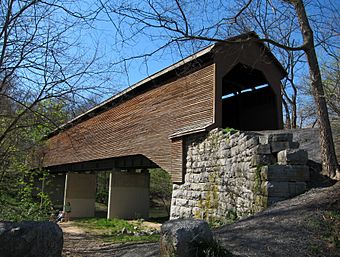Meems Bottom Covered Bridge facts for kids
|
Meems Bottom Covered Bridge
|
|

Meems Bottom in 2016
|
|
| Location | Route 720 over the North Fork of the Shenandoah River, Mount Jackson vicinity |
|---|---|
| Built | 1894 |
| Architectural style | Burr Truss |
| NRHP reference No. | 75002037 |
Quick facts for kids Significant dates |
|
| Added to NRHP | June 10, 1975 (original) April 23, 2008 (update) |
The Meems Bottom Covered Bridge is a special covered bridge in Shenandoah County, Virginia, United States. It is the longest covered bridge in Virginia, stretching about 204 feet (62 meters). What makes it even more unique is that it's one of the few covered bridges in Virginia that cars can still drive across every day!
This historic bridge is near the town of Mount Jackson. It was built in 1892 by Franklin Hiser Wissler. He needed a way to get to his apple orchards at Strathmore Farms, which were on the other side of the North Fork of the Shenandoah River. The Meems Bottom Covered Bridge was added to the National Register of Historic Places on June 10, 1975, recognizing its importance.
Contents
History of the Bridge
People believe there were at least two bridges in this area before the current one. These earlier bridges were sadly lost to floods or fire. One bridge was likely burned in 1862 by soldiers led by Stonewall Jackson during the American Civil War. Another bridge was washed away by floodwaters in 1870.
The name "Meems Bottom" comes from the Meem family. They owned a lot of land in this area. The wood used to build the 1894 bridge came from a nearby farm called Strathmoor. This farm used to belong to a Confederate General named Gilbert S. Meem.
Civil War Events at the Bridge
During the Civil War, the area around the bridge was very important. On October 3, 1864, a group of Confederate soldiers called McNeill's Rangers, led by Captain John McNeill, attacked Union soldiers guarding the bridge. The fight was quick, lasting only about fifteen minutes. Most of the Union soldiers were captured. Sadly, Captain McNeill was badly hurt during this attack and later died.
Building the Current Bridge
The Meems Bottom Covered Bridge you see today is actually the fourth bridge built at this spot.
- The first bridge was built around 1867-1868 but was destroyed by a flood in 1870.
- A second bridge was built by 1871, but it was also destroyed by floodwaters in 1877.
- A third bridge was built in 1878.
- The current bridge was built in 1894.
John Woods was hired to build the 1894 bridge. A lot of timber, about 57,000 feet (17,374 meters) of wood, was cut from local trees by J. L. Olinger.
How the Bridge Was Built
The Meems Bottom Covered Bridge uses a special design called a Burr Truss. This design was created by Theodore Burr in 1817. He was the brother of Aaron Burr, who was once a Vice President of the United States.
The bridge is 204 feet (62 meters) long, making it the longest covered bridge still standing in Virginia. It is supported by two strong stone structures called abutments on each side of the river. These stone supports go ten feet (3 meters) deep into the riverbed. The rocks for these supports came from local quarries.
The bridge has two large wooden arches on each side. These arches are made of three sections of strong timbers, each about 7 inches (18 cm) by 15 inches (38 cm), bolted together. The other wooden parts that hold up the roof and the roadway are also made of thick timbers.
In 1937, the bridge was made even stronger. Steel beams were added along the length of the bridge, and a new road surface was put in.
Fire and Reconstruction
On October 31, 1976, the bridge was sadly damaged by fire. However, the original wooden parts that could be saved were used again. The bridge was rebuilt and opened to traffic again by September 1979. During this restoration, new concrete piers and steel beams were also added to make it even more durable.
The Meems Bottom Covered Bridge was added to the National Register of Historic Places on June 10, 1975. It was updated on April 23, 2008. It is also listed on the Virginia Landmarks Register, first on April 15, 1975, and updated on March 10, 2008.



